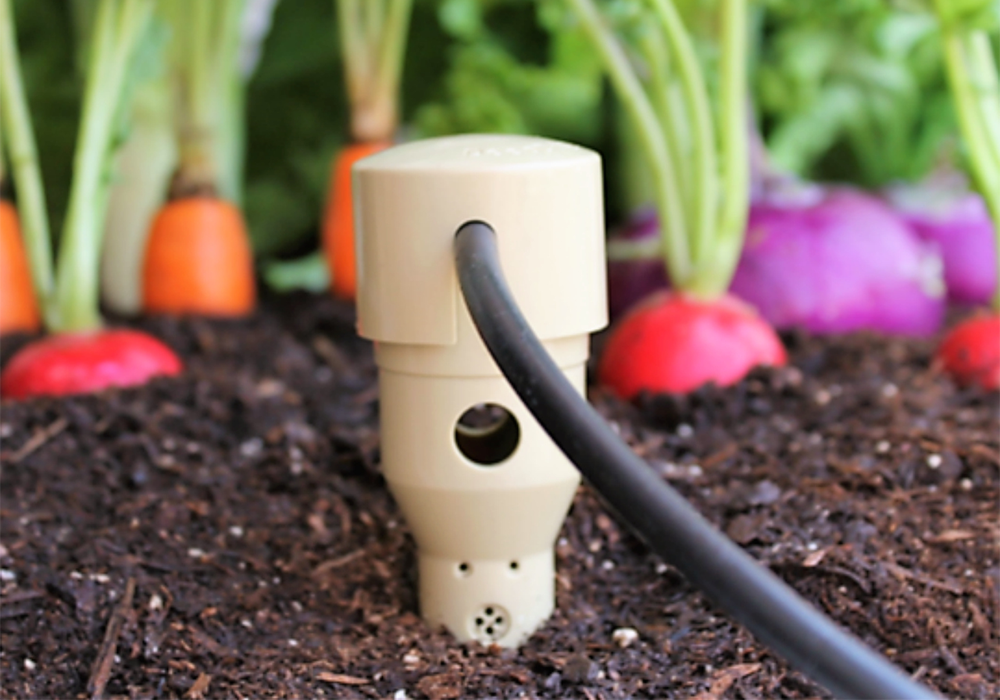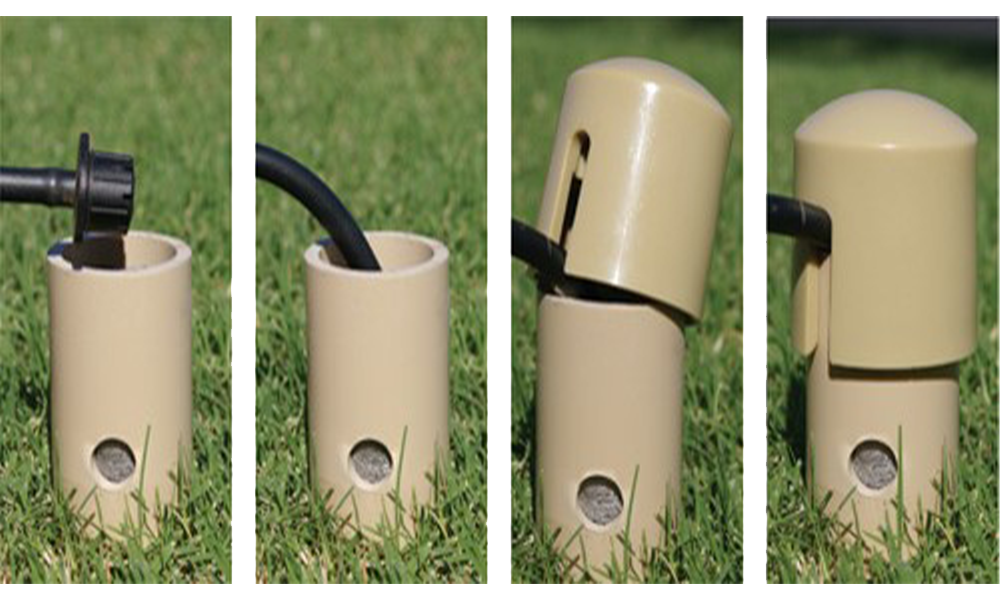
Deep Drip Tree Watering Stakes aid in the watering and fertilization of your trees at the roots, in addition to better aerating the soil with oxygen. Deep Drip will deeper saturate the ground around your tree allowing the roots to grow deep and strong instead of horizontally at the surface, possibly resulting in exposed roots. This device is designed to work with a garden hose, flood irrigation, or in conjunction with your automatic landscape drip system.
Your standard 1/4" drip line easily connects to the Deep Drip spike. And you can also add fertilizer into the shaft to continually direct nutrients to the root zone. Whether you have fruit, oak, or palm trees, start watering your trees where the roots are and where you want them to be. Roots tend to follow the water source, so show your roots the path to growing deep. When you can get water underground faster, you can water for shorter periods, while practicing sensible water conservation. Our Patent Pending Deep Drip tree root watering devices are made in the U.S.A. and come in three sizes: 14, 24, and 36 inches.
Our Deep Drip tree root watering devices come in three lengths: 14, 24, and 36 inches. The 14-inch unit is perfect for small trees and shrubs with shallow roots, like rose bushes, ornamental trees, or in commercial use for trees still in boxes. The 24-inch unit is used for your average trees, while the 36-inch unit may be used for palm trees and deeper rooted trees.
The devices are constructed of sturdy ABS and PVC. The reinforced tip and cap are made from ABS, while the upper shaft is made from Schedule 40 PVC. There are multiple holes in the bottom half of the spike, internally covered by a mesh filter that allows water to flow out, but keeps dirt from getting in, settling, and clogging the tube. The UV-protected cap has multiple functions, a sit acts as a Protective/reinforced cover when hammering into the ground, keeps rocks and leaves from entering the shaft, and holds the inch drip line securely in place. And in many parts of the country, the cap also protects the emitter head from squirrels or other animals.
Periodically, as the tree grows and roots extend farther away from the tree, repositioning the device beneath the outer edge of the tree's canopy is recommended. The upper shaft has two holes at the top so the user can remove and replace the unit as needed. Just insert a screwdriver or like tool through the holes and pull up.
Installation
There are two ways to install the Deep Drip tree watering stakes. Either by inserting the units during new planting or by driving the unit into the ground (while wearing protective eyewear, of course) around an existing tree. The reinforced pointed tip and specially designed cap are engineered to take quite a beating.
During one test on extremely hard ground, our researchers used a 3-pound sledgehammer, pounding the device 484 times to get a 36" unit into the ground. Obviously, this was very hard ground and most installations may only require a couple of dozen hits, although we mention this to show you the strength and durability of our units.
Step One
Designate a location for the Deep Drip tree root watering tool installation. Choose a spot free from underground lines and pipes; select the location that is approximately halfway between the tree trunk and the outer edge of the tree's canopy. Newer trees are recommended to have 2-3 units on opposing sides or surrounding the tree base. Older, more established trees may need as many as 5-6 stakes to fill the circle around the tree
Step Two
During New Installation of Tree: After the tree has been placed in the hole, insert 2-3 Deep Drip units vertically in the hole surrounding the tree before back-filling with soil. The top of Deep Drip can either be above ground level or below ground, depending on your preference.
Installation at Existing Tree: If you are installing a Deep Drip at an existing tree where a hole no longer exists, then you will need to either dig a hole or drive Deep Drip into the ground manually. To drive into the ground using a sledgehammer, place a slotted end cap on the open end of the shaft without the drip line inserted (Fig. 2). Always wear protective eyewear. Do not directly hammer the 'uncapped' end into the ground as this could break or destroy the shaft. A three-pound sledgehammer is recommended to drive the unit into the ground. Drive Deep Drip completely into the ground or leave the cap visible, whichever is preferable.
Troubleshooting: If soil is too dense, water the area around the tree and use a soil softener to soften the ground before inserting. Also, recommend inserting stake or rod into the ground and remove to clear pathway for a unit. Drilling into the ground using an auger bit is another way to clear the pathway for a unit. Again, make sure you are aware of any underground lines or pipes and do not insert where they may exist.
Step Three
When positioned in the ground, remove the cap and insert the end of the existing drip line and emitter into the shaft aligning the drip line with the slot in the cap (Fig. 3). Re-install cap to secure drip line and stop excess debris from entering the shaft. We also recommend placing an emitter at the surface in addition to the Deep Drip units(as seen in the illustrations on the Home Page). This will ensure that the shallow roots will get the much-needed water as well as the deeper roots.
When using a hose, we recommend that you create a small berm around your tree to hold in the water and prevent run-off. Bury 2-3 Deep Drip stakes equally spaced within the berm around the tree. Remove the caps from the stakes; lay the slow-flowing hose within the berm and the water will saturate the shallow roots near the surface and eventually flow down into the stakes to water the deeper roots. The harder the ground, the slower and longer the flow you will need to saturate the root zone.
Idea: Pour granulated tree fertilizer into the shaft after positioning it in the ground. Water will pass through and slowly dissolve nutrients, feeding the tree at the roots.
Step Four
To Remove: Insert rod or standard screwdriver through the two holes in the main shaft just below the cap. Slide the rod through the shaft and pull up (Fig.4). Slightly twisting the shaft may be necessary for easier removal. Every six months it is recommended to rotate the unit 360 degrees while in the ground to keep the small roots from entering the shaft. Just insert a screwdriver or rod and twist.
Step Five
Watering and Fertilization: Ask your local lawn and garden professional for recommendations on watering levels, emitters, and different types of tree fertilizer, specific to your tree's needs.
| Brand | Underhill |
|---|---|
| Product Type | Tree Watering Stakes & Bags |
| Warranty | 2 Years |
| Length | 14.5 in. |


